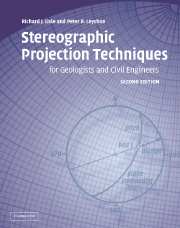Book contents
- Frontmatter
- Contents
- Preface
- Acknowledgements
- Stereographic Projection Techniques for Geologists and Civil Engineers
- Appendix 1 Stereographic (Wulff) equatorial net
- Appendix 2 Equal-area (Lambert/Schmidt) equatorial net
- Appendix 3 Equal-area polar net
- Appendix 4 Kalsbeek counting net
- Appendix 5 Classification chart for fold orientations
- Appendix 6 Some useful formulae
- Appendix 7 Alternative method of plotting planes and lines
- Availability of computer programs for plotting stereograms
- Further reading
- Index
Appendix 7 - Alternative method of plotting planes and lines
Published online by Cambridge University Press: 05 June 2012
- Frontmatter
- Contents
- Preface
- Acknowledgements
- Stereographic Projection Techniques for Geologists and Civil Engineers
- Appendix 1 Stereographic (Wulff) equatorial net
- Appendix 2 Equal-area (Lambert/Schmidt) equatorial net
- Appendix 3 Equal-area polar net
- Appendix 4 Kalsbeek counting net
- Appendix 5 Classification chart for fold orientations
- Appendix 6 Some useful formulae
- Appendix 7 Alternative method of plotting planes and lines
- Availability of computer programs for plotting stereograms
- Further reading
- Index
Summary
Several textbooks describe a method of plotting that differs from the one proposed in this book. In contrast with the one recommended earlier, the alternative method involves rotating the tracing paper above a stationary net. The alternative procedure is best explained with reference to an actual example.
Plotting a plane 060/30SE as a great circle and a pole
1 Mark the north mark and the strike direction 060 on the tracing paper (Fig. A7d).
2 Keeping the net still, rotate the tracing paper until the strike mark aligns with the axis point of all small circles on the net (Fig. A7e).
3 Trace the appropriate great circle, i.e. the one found by counting in 30° from the ‘south’ (Fig. A7e). This is great circle for the plane 060/30SE.
4 With the tracing held in the position, count out an angle of 90° from this great circle. This gives the pole of the plane 060/30SE.
5 The completed stereogram is shown in Figure A7f.
Plotting a line 30–050
1 Rotate the tracing until the north point rests adjacent to the 050° bearing on the underlying net.
2 Now measure 30° along the 0–180 diameter of the net from the periphery at 0 towards the centre and insert the point representing the line 30–050.
3 Restore the tracing to its correct alignment.
- Type
- Chapter
- Information
- Publisher: Cambridge University PressPrint publication year: 2004



